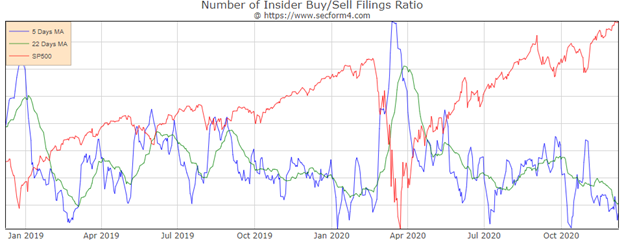Insider buying is falling…here’s why that may not be as big of an issue as some investors think

It is important to understand how management members think about their own companies. They are the ones driving company performance, so any insight into their thinking is helpful. One way to understand their outlook on their own companies, at least their companies’ stocks, is through insider buying and selling.
Today, we will look at insider buying and selling and what it means for the market and investors.
Investor Essentials Daily:
The Monday Macro Report
Powered by Valens Research
Recently, The Economist wrote a fantastic piece about the role of the board of directors. The article did a great job of talking about the role board members should be playing for public companies and cultural institutions.
The piece mentioned some of the rules Sir John Tusa wrote about in his book, On Board: The Insider’s Guide to Surviving Life in the Boardroom.
Tusa wrote about multiple rules and practices members should follow in the pursuit of good governance. One is to take time when hiring those in executive roles. The relationship between a chief executive and chairman of the board is vital. As such, prior to hiring, the two should look to build a rapport.
Tusa also wrote more about the chairman of the board. He stated the chairman of a board needs to be on the same side as the chief executive officer (CEO) until there is no option not to be. Bad chairmen too often try to impose their own views. Instead, they should be facilitating communication with the CEO and rest of the board.
As the article talks about, this is vital as board members are often in the dark. The role of non-executive board directors is usually not well defined. Because of this, they can end up being glorified figureheads.
A diligent chairman and insightful question asking by board members can keep them both informed and useful. This active role can be dangerous, as board members are stuck between a rock and a hard place. Either they ask too many probing questions, and they do not receive an invitation to come back on the board, or they are stuck in the dark.
For investors, understanding the board and management dynamics is important. This is in terms of how they work together, their shared outlook, and their strategy and intentions. While it is often under-prioritized in investing, it is a necessary piece of the puzzle in valuing companies.
We can gain a window into management’s outlook through insider buying trends. This allows us to see how management teams are voting with their wallets.
We last looked at this topic two months ago. At the time, the ratio between insider buying and selling was beginning to rebound, brushing the top of long-term average levels. It rose at the beginning of the pandemic, then collapsed before hitting a short-term peak.
Now, it’s crucial we revisit this important metric now that the election is over and the vaccine is starting to be distributed. Management teams now have more clarity on 2021 than in October.
In recent months, the ratio between insider buying and selling has been volatile. The measure skyrocketed before the election and fell right after. Since then, the ratio has been declining again to below long-run average levels.
One reason is most management teams are value investors. Therefore, we saw them funnel money into their company’s stock when the pandemic began. Some of their companies’ stocks were down more than 50% in March. For executives who knew their companies had the liquidity and positioning to survive the pandemic, they were salivating at the opportunity to buy equity at such depressed valuations.
This is part of the reason why insider buying has moderated in recent months. With the S&P 500 now at all-time highs, some valuations are far less attractive.
So with the S&P pushing above 3,700, it is not surprising to see investors not still buying in droves. However, management members are confident enough to still hold material amounts of their own companies’ equity.
If they were concerned about outlook or thought their stock price was too high, it is likely insider selling levels would be even higher than they are now.
Management buying and selling is an essential metric to follow. These insiders know more about their companies than anyone. The greatest way to understand how these members think about their stock is though watching what they’re doing with their wallets.
We are seeing buying moderating, but we are not seeing a mass sell-off, even as the market pushes higher. Given management members are not panicking and bailing out of their stock, we continue to suggest investors follow suit.
Best regards,
Joel Litman & Rob Spivey
Chief Investment Strategist &
Director of Research
at Valens Research





